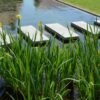If you’re new to the world of pond pumps and fountains, choosing the right-sized pond aerator can seem daunting. An aeration pump will maintain the health of your pond. We’ll help you choose a pond pump size that will be perfect for your pond. With our guidance, you’ll have a great idea of what pond pump size is best for you.
This article will explain how to aerate your pond and the benefits it brings to the health of your pond. Aeration for ponds includes types, as well as determining what aeration technique will work best in your pond, lake, or waterway.
Incorporating an aeration system into your pond can have many benefits. In addition to ensuring your fish, plants, and shrimp receive well-oxygenated water in order to survive, well-oxygenated water also increases the tranquility of your aquarium.

It is essential to maintain a well-oxygenated koi fish pond because there are many negative effects to low oxygen levels, including harmful algae blooms. Acid rain, surface run-off, excess leaves, algae, and the degradation of your pond can all lower the dissolved oxygen levels.
To ensure your habitat’s success, it is crucial that your pond is properly aerated.
How does pond aerator work?
By aerating your pond water, you mix air with a liquid.
The importance of aeration in the health of ponds and their inhabitants may be familiar to some of you. Any element in water has a vital role to play – oxygen is no different. You might have trouble managing algae control in your pond or losing fish if you don’t have enough dissolved oxygen in your pond.
Proper aeration can be accomplished in a variety of ways. You can use basic aeration equipment or more advanced custom aeration equipment. An overview of a few popular tools to aerate ponds is presented here. The pond scum on the surface and string algae will both need to be scooped up.
What are the benefits of pond aerator?
Fish food and fish waste are often the cause of high nitrogen levels in small fish ponds. As fish require oxygen to digest their food, there will always be instances when there will be too much decomposing organic waste or too many fish in a pond as this can cause dissolved oxygen levels to drop dramatically, causing fish kills and algae blooms.
You should choose the aeration technique according to your budget and the style of your pond. Aeration also adds an aspect of aesthetic beauty to your pond. It will naturally help diffuse oxygen so that it will be present on the surface. An underwater current will also help to aerate the water surrounding your pond. Furthermore, you do not have to choose just one aeration method. For example, there are many plants that naturally help to aerate ponds.

Aeration Mechanisms in Ponds
The waterfall is an effective way to increase aeration by adding a natural look to ponds and water gardens. One of the more elegant selling points of waterfalls is aesthetics (such as sounds of babbling water and the sun glistening off cascading water).
Advantages
- Enhances the natural appearance of the pond
- This simulates aeration in nature
- Isn’t as obtrusive as mechanical devices
Limitations
- It may be time-consuming and costly to install if it is not naturally occurring
- Usually less effective than mechanical aerators
- Leaks will drain the pond over time, requiring more upkeep
Having trouble deciding which method is best for aerating your pond?
It’s not just you. There are several different methods of aeration for ponds, each of which respond differently. Any pond owner must find a way to increase oxygen levels in their pond in the most efficient manner. Most often, knowledge of the plethora of aeration techniques is achieved through trial and error. However, ponds that have water features such as waterfalls, fountains, wind aerators, paddlewheels, or horizontal aspirators (to name a few) can always benefit from adding a supplement to improve the balance.
An aerated subsurface system consists of the following components:
Let’s begin by learning about the components of an aeration system. In general, a system of subsurface aeration consists of 3 main components.
- A compressor is the heart of the system, it produces compressed air that is sent to the bottom of the pond. Most compressors are placed near the shoreline, but they can also be placed hundreds of feet away from the pond.
- It is the tubing that carries the compressed air down to the pond bottom. PVC and Vinyl tubing are the most commonly used types. When the compressor is running, vinyl tubing has thin walls and floats, it must be weighted in order to stay submerged. PVC tubes are thicker and heavier than other tubing materials. It remains at the bottom at all times and will last longer than the other ones as well.
- The diffuser is attached to the airline at the bottom of the pond. By breaking up the air into fine bubbles, the air is circulated and aerated more effectively. Diffusers come in a variety of types.
Choosing the Right Pond Aerator Size
There are three important factors that you need to consider when sizing an aeration system for your pond if you plan to install one.
- Amount of depth
- Location
- The shape.
1. Pond Depth
Most people overlook the depth of their pond when installing a subsurface aerator. ponds can be roughly classified into two groups based on their depth – shallow ponds and deep ponds – when considering an aeration system.
Ponds that are 6 feet / 1.83 meters or less in-depth are called shallow ponds. Shallow Pond aeration systems are the best choice for ponds that are 6′ deep or less. Typically, shallow ponds use either linear piston compressors or linear diaphragm compressors. Despite their efficiency, reliability, and a large volume of air production, these compressors work only in ponds that are 6′ to 7′ deep.
Ponds with a depth greater than 6’/1.83m are considered deep ponds. Whenever you are diving deeper than six feet / 1.83 meters, there are two excellent options. Rocking piston compressors are the most common type. They are powerful, economical, produce ample airflow, and are optimal for depths between 7′ and 50′. In ponds that are between 5′ / 1.5 m and 16′ / 4.9 m deep, Rotary Vane compressors are becoming more common. The compression in these compressors is greater compared to a Rocking Piston compressor; however, they are more expensive and can’t be used in very deep ponds.
2. The shape of a pond
Aeration systems are also shaped by the shape of your pond.
Aeration is a natural property of circular or round ponds. The air in a round pond is usually sufficiently aerated by a diffuser placed in the center. Upon spreading out at the surface of the pond, the bubbles create ripples that radiate outward. If, however, the pond is long, narrow, or irregular shaped, two or more diffusers are often needed to circulate the water effectively.
3. Surface Area of a Pond
The size of an aeration system required to properly aerate a pond is dependent on the surface area of the pond. The size of the pond will require a larger air compressor capable of powering multiple diffusers if the depth and shape are the same.
Our handy calculator can help you determine the surface area and volume of your pond if you know its approximate dimensions.










